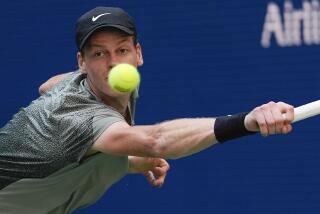U.S. Open Notebook : Computer Rankings Merely a Numbers Game
- Share via
NEW YORK — Flesh and blood determine victory and defeat on the professional tennis circuit, but the bottom line--the all-important world ranking system--is the product of computer technology.
It is probably the most efficient and effective way to classify players according to their ability. For instance, Mats Wilander, the computer’s No. 3-ranked male player, certainly deserves to be 100 notches ahead of No. 103 Wally Masur.
But there are those at this year’s U.S. Open who are wondering about the accuracy of the current computer rankings. Their credo: To err is human, but to misrepresent is electronic.
In the men’s division, for example, Ivan Lendl is rated No. 1 and John McEnroe No. 2--even though McEnroe has beaten Lendl twice this month. And in the women’s division, Chris Evert Lloyd is ranked first and seeded first at the Open, ahead of Martina Navratilova, despite Navratilova’s victory over Lloyd at Wimbledon and her 1984 championship here at Flushing Meadow.
That’s partly due to the time frame programmed into the computer. Players are ranked according to their results of the previous 52 weeks--not just what they have done this calendar year.
“The ranking is for the last 12 months, and it doesn’t show how you do against the one or two guys on the top,” said Lendl, who Wednesday scored a 6-2, 6-1, 6-3 first-round triumph over Jay Lapidus. “It shows how consistent you are over the year and probably for that reason I was ranked No. 1.
“There have been times when I felt I should have been ranked higher on the computer than I was, and there have been times when I felt I shouldn’t be as high and I was. The computer isn’t absolutely fair, but that’s the way it comes out and we’ve got to cope with it.”
Navratilova, long accustomed to the prestige of No. 1, admitted she had trouble coping at first when the computer dropped her to No. 2.
“For a while, I was sulking after Wimbledon,” said Navratilova, a 6-2, 6-1 first-round winner over France’s Pascale Paradis. “I figured I should be No. 1, but the computer ranking didn’t say so. So, I was beginning to wonder what I had to do to be No. 1.”
Finally, Navratilova decided to use the computer’s printouts as motivation for the U.S. Open.
“I figured that I should make it work for me, instead of against me, and if anything, it should help me,” she said. “If I play Chris in the final, it doesn’t matter who is No. 1.”
Such a matchup seems likely. Lloyd also coasted in her first-round match, beating Australia’s Janine Thompson, 6-1, 6-3.
But although she’s ranked and seeded No. 1, Lloyd still talks about her rivalry with Navratilova as if she’s the challenger.
“Last year at this time, when I lost to her in the U.S. Open, I realized that physically it was pretty close,” Lloyd said. “It was just a matter of mentally believing I could win. . . . I think that first win in January in Key Biscayne this year helped me a lot. It’s just the belief that I can compete at her level, not necessarily to win or lose.”
Lloyd is now a believer. She’s the favorite here. The computer says so.
Sabatini Sabotaged: On the day the Women’s Tennis Assn. adopted new guidelines restricting the eligibility of young tennis pros, the tour’s brightest young star, Argentina’s Gabriela Sabatini, burned out in the first round against Barbara Potter.
Sabatini, a French Open semifinalist and the 10th-seeded player at the U.S. Open, lasted only 56 minutes against Potter, who scored a 6-4, 6-2 victory.
At 15, Sabatini will be affected by the new guidelines concerning teen-age female tennis pros. The guidelines, adopted as a response to the malady commonly known as tennis burnout, will limit players younger than 15 to 10 tournaments a year, and players 15 and 16 to 12 tournaments a year.
The guidelines also call for players under 16 to take two 30-day rest periods each calendar year and for players under 18 to attend a seminar addressing “the benefits and problems of professional tennis.”
The WTA eligibility rule will be submitted to the Women’s International Professional Tennis Council for final approval next week.
More Upsets: Kathy Rinaldi, a Wimbledon semifinalist, and Henrik Sundstrom, one of the heroes of Sweden’s 1984 Davis Cup championship, were also surprise losers in the first round Wednesday.
Rinaldi, seeded ninth in the women’s field, was eliminated in a pair of tiebreakers, 7-6, 7-6, by Czechoslovakia’s Andrea Holikova. The tiebreaker scores were 7-3 and 8-6.
Sundstrom, who beat McEnroe in last year’s Davis Cup final and was seeded 14th in the men’s draw here, saw his base-line game ground up by Argentina’s Martin Jaite, 6-4, 2-6, 6-2, 6-3.
Elsewhere in the men’s bracket, Jimmy Connors, No. 4; Yannick Noah, No. 7, and Miloslav Mecir, No. 9, advanced as expected.
Connors beat South Africa’s Gary Muller, 6-4, 6-3, 4-6, 6-2; Noah bested Great Britain’s Jeremy Bates, 6-3, 7-6, 6-3, and Mecir rallied to defeat Andy Kohlberg, 5-7, 4-6, 7-6, 6-3, 6-1.
In the women’s division, Pam Shriver, No. 4, was a 6-3, 6-3 winner over Denmark’s Tine Scheuer-Larsen, and Steffi Graf, No. 11, downed Patty Fendick, 4-6, 6-1, 7-5.
More to Read
Go beyond the scoreboard
Get the latest on L.A.'s teams in the daily Sports Report newsletter.
You may occasionally receive promotional content from the Los Angeles Times.










